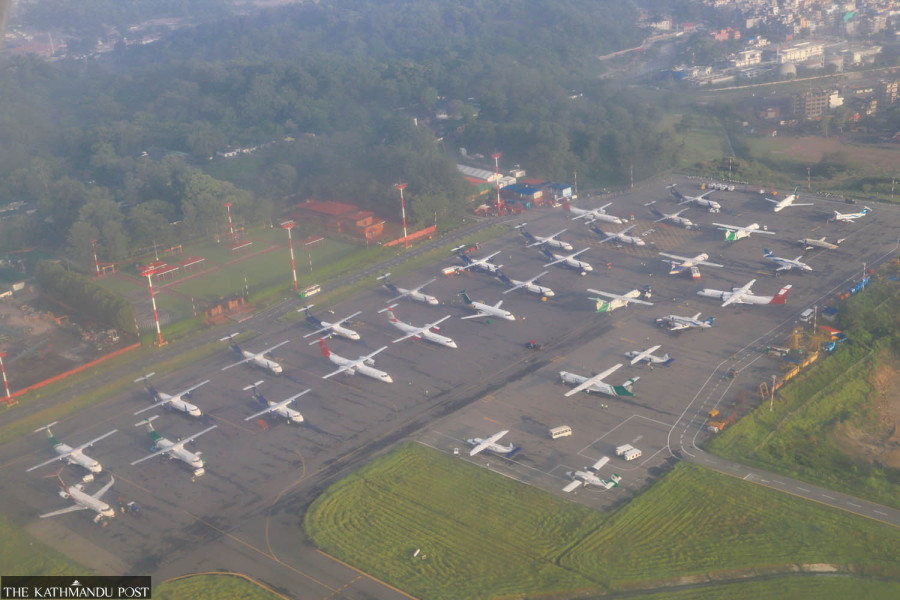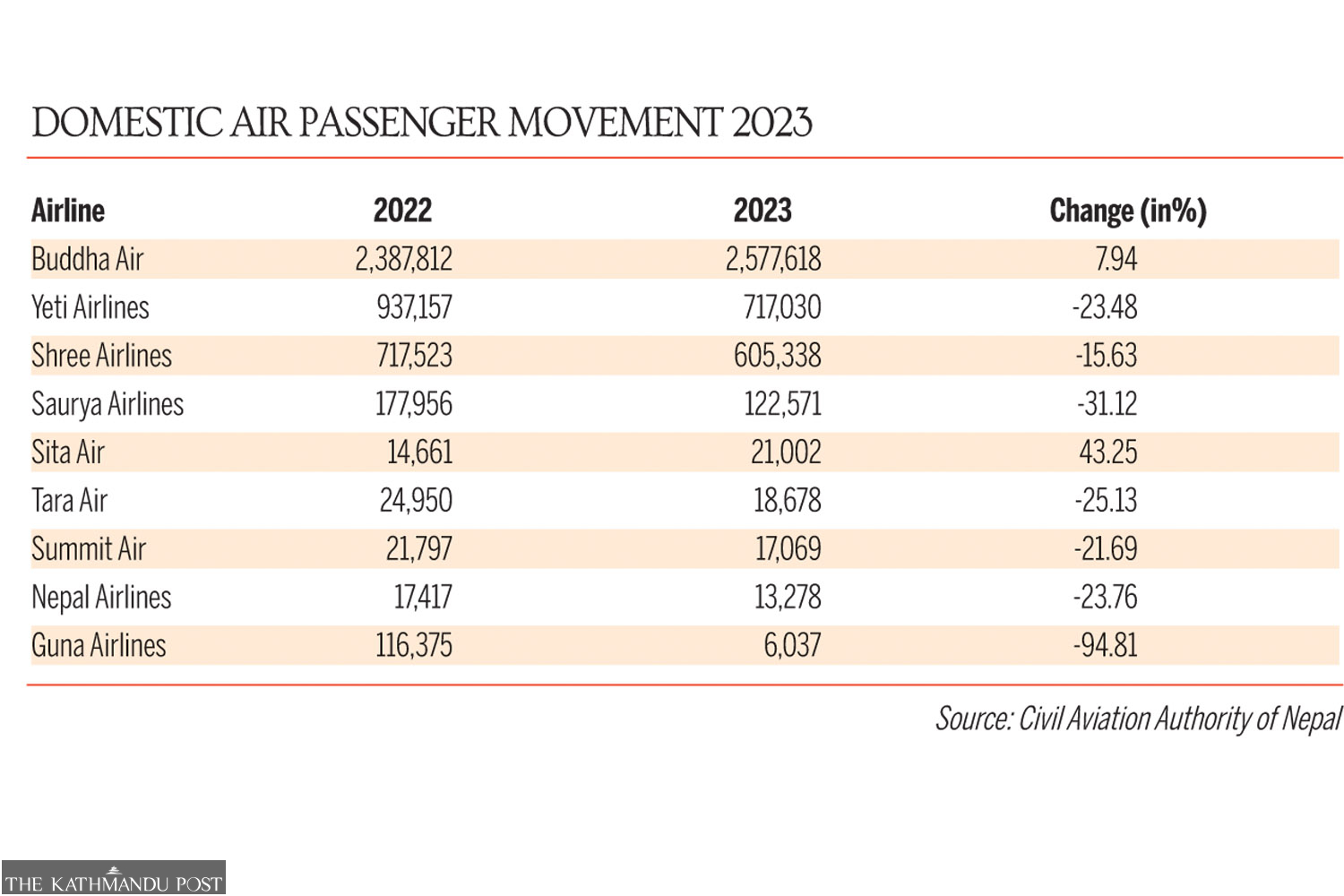Money
Domestic air travel shaken by slowdown, taxes and crashes
Nepal’s domestic airline companies flew 4.15 million passengers in 2023, losing 315,826 flyers in a year.
Sangam Prasain
Domestic air travel was hit hard by the economic slowdown, high taxes and crashes in 2023. This was in sharp contrast to 2022 when passenger numbers boomed.
Nepal’s domestic airlines—nine fixed-wing operators and 12 helicopters—flew 4.15 million passengers in 2023.
According to Tribhuvan International Airport statistics, domestic airlines saw a sharp 7.07 percent drop in passenger growth in 2023, as compared to 2022 figures.
This translates to a loss of 315,826 flyers in a year.
“There are many factors behind the drop in passenger numbers in domestic airlines. A key reason was the economic slowdown,” said Pratap Babu Tiwari, general manager at the Tribhuvan International Airport.
“Besides, high airfare also discouraged passengers from flying,” he said.
The year 2021 started with a robust passenger demand despite a Covid surge.
In 2022, when the Covid cases receded, airlines launched promotional fares to attract flyers despite the staggering rise in fuel prices that had reached Rs190 a litre, resulting in an all-time high passenger numbers.
Then, the country suffered a recession. Nepal plunged into its first recession in six decades last year as economic output continued to be weighed down by inflation and political instability.
The repercussions were also visible in the travel market.
Although the jet fuel price dropped to Rs136 a litre in July last year, its impact was not visible in the domestic airlines’ occupancies.
Some airline officials say that the deadly Yeti Airlines crash of January 15, 2023, which killed all 72 people on board, also discouraged people from taking to the skies.
From January 15 to March last year, after the Yeti crash in Pokhara, domestic airlines’ occupancy dropped below 40 percent, industry insiders say.
The industry suffered a bigger jolt after two planes crashed in less than a year.
Fares went 25 percent higher on many routes in 2023 than they were a year ago.
The government then imposed 13 percent VAT on air tickets from mid-September last year making flying more expensive. Before that, the civil aviation body doubled the service charge for domestic passengers and increased it threefold for international passengers.
“2023 was the worst year for airlines, worse than the Covid period,” said Anil Manandhar, corporate manager of Shree Airlines. “There was an economic slowdown that eroded people’s income. The VAT on air tickets further compounded the problem.”
Air tickets were available for as low as Rs1,500 for a Kathmandu-Pokhara flight and Rs2,000 for Kathmandu-Bhadrapur flights post-Covid—which was close to bus ticket rates.
When the competition heated up, many airline companies saw their revenue stream in a tailspin, industry insiders say.
Guna Airlines folded in February 2023 after its cash stream stopped.
Manandhar said that 2024 is also not looking good for domestic airlines. “The cancellation has been huge this winter. We hadn’t seen such cancellations during the winter before,” he said.
Cold waves, a stagnant blanket of thick smog, are lasting longer in the Tarai region in the absence of winter rainfalls and the impact is becoming severe not only for crops but also for airlines.
“This winter, the number of passengers has increased due to ongoing road expansion in most of the country but cold waves have prevented airlines from reaping the bonanza,” Manandhar said.
The statistics show flight movements dropped by a double-digit rate last year.
There were 96,989 domestic flights in 2023, down 10.36 percent from 2022.
On average, 266 domestic flights took off and landed daily at the Kathmandu airport in 2023, from the normal 297 flights.
While Nepal’s privately-owned airlines have largely accomplished their fleet expansion plans following the expansion of airport infrastructure, the new airports, however, did not support the aviation industry’s growth, experts say.
The night infrastructure in most of the airports have enabled airlines to fly three shifts—18 hours a day. Eight airports in Nepal are now equipped with the technology to allow night flights.
A few years ago, planes were allowed to fly only up to 5 pm.

A breakdown of passenger numbers in 2023 shows that Buddha Air was the clear winner in passenger movement. Except for Buddha Air and Sita Air, all domestic carriers recorded negative passenger growth last year.
Buddha Air recorded a steep 7.94 percent growth in passenger numbers last year, compared to 2022, flying 2.57 million passengers. Buddha Air, which currently has 17 aircraft in its fleet, grabbed 63 percent of the passenger market share.
Buddha’s closest rival, Yeti Airlines, saw its passenger numbers drop by 23.48 percent to 717,030 in 2023, compared to 2022.
Shree Airlines, which diversified into fixed-wing services in April 2017, flew 605,338 passengers in 2023, down 15.63 percent year-on-year.
Likewise, Saurya Airlines, which started operations in November 2014, carried 122,571 passengers in 2023, down 31.12 percent, compared to the 2022 figures.
Guna Airlines, which made a comeback in 2021 by buying five Jetstream 31 aircraft from Yeti Airlines, flew 6,037 passengers in 2023. It recorded a staggering drop of 94.81 percent in passenger numbers. The airline folded in February 2023.
Yeti’s subsidiary Tara Air, which only operates in the remote sectors, also saw a negative growth in passenger numbers in 2023. It flew 18,678 passengers last year, down 25.13 percent from a year earlier.
Summit Air, another airline serving remote destinations, saw its passenger numbers drop 21.69 percent year-on-year to 17,069.
The year 2023 was painful for state-owned Nepal Airlines. The national flag carrier saw its passenger numbers come down by 23.76 percent to 13,278 in the review period.
Nepal Airlines’ passenger numbers dropped after it decided to ground all of its six Chinese-made planes in 2020 in a bid to cut losses. It currently flies two vintage Twin Otters.
Sita Air carried 21,002 passengers, a 43.25 percent year-on-year increase, in 2023.




 9.12°C Kathmandu
9.12°C Kathmandu













%20(1).jpg&w=300&height=200)
